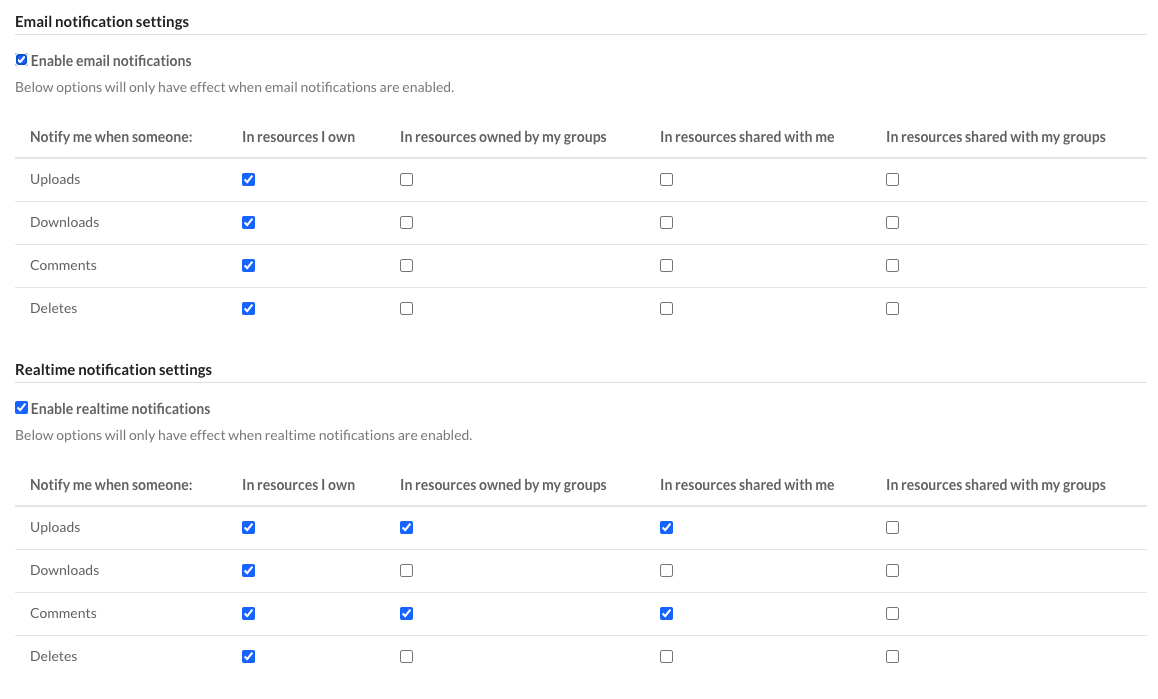Configuring FileAgo
Administrator can configure FileAgo by accessing Admin Panel -> Settings.
This page is only available for admin users of FileAgo Self-hosted servers.
The options here are critical for the smooth running of FileAgo, and any misconfiguration could easily lead to disruption of service. For this reason, only FileAgo support team have access to this page in a FileAgo Cloud server.
General
Hostname
Enter the hostname (FQDN) of your installation. Among other things, this value is used to make URLs that are sent via emails. If hostname is not available, you can use IP address instead.
Email Server
This section is used to configure the SMTP server which will be used by FileAgo to send email notifications to users.
SMTP Server
Enter the hostname (FQDN) or IP address of the SMTP server to use.
SMTP Username
Enter the username to authenticate with the SMTP server.
SMTP Port
Enter the port at which SMTP server is listening. Usually, it is 25 or 587 but can vary.
Send email notifications as (FROM:)
Email notifications will have this email address as its source (FROM: address).
Outgoing webhook
This setting is only required if you have an external service which needs to receive information when events happen in FileAgo. If not (like in most situations), simply leave the ‘Endpoint URL’ field blank.
Endpoint URL
FileAgo will POST all events related to files and folders as json data to the URL that you enter here. It is highly recommended to use https protocol (with a valid certificate), and to refer the endpoint by its hostname.
Document revisions
Keep old revisions of documents?
Using this option, an administrator can configure how many days should old versions of files be available, after which the original data file will be safely removed. It is possible to preserve all revisions (i.e., FileAgo will never remove any old revisions) by selecting the option ‘Keep forever’ from the dropdown.
Admin settings
Admin Email
Email address of the administrator
Admin Password
Password of the admin user account.
Database
Database Host
Enter the hostname (FQDN) / IP address of your database server.
Database Host Port
Enter the port on which your database server is listening to (usually 7474).
Database Username
Enter the username of the database server.
Database Password
Enter the password of the database user.
Security
CORS ‘Access-Control-Allow-Origin’ header
Enter * or hostname if you have 3rd party applications or mobile applications that will connect to FileAgo using API. Else, leave the field empty.
Only group permissions matter when group members try to access files owned by a group
This option is enabled by default. Disabling this will result in stricter permission checks for a user when trying to access resources owned by a group. The option has been discussed in detail in the Waterfall Permission Model section.
Temporary ban for failed login attempts
Enable temporary IP ban for preventing someone from guessing passwords. Additional settings can be configured below.
Temporary ban settings
Max failed logins
Enter the number of failed logins that will trigger a ban (default: 5).
Interval (in minutes)
Enter the interval of time (in minutes) during which maximum failed logins should occur from an IP to trigger a ban (default: 1).
Ban duration (in minutes)
Enter the period for which a temporary ban must last (max: 120 minutes, default: 15).
The default values here says that if temporary ban is enabled, then an IP address will be banned from accessing the API endpoints for the next 15 minutes if 5 failed login attempts happen from that IP address within a period of 1 minute. The ban will be revoked automatically after the interval is over.
Notifications
This section describes the global email and realtime notification settings.
Email notification settings
Enable email notifications
This option needs to enabled (along with a working SMTP server configuration) in order for FileAgo to send outgoing email notifications.
Configure the following options for whichever events should email notifications be sent to the users.

For example, the first row can be interpreted as:
Alert a user by email if some oneone uploads a file which satisfies any of the below conditions:
- The file is uploaded in a folder owned by the user
- The file is uploaded in a folder owned by one of the groups in which this user is a member
- The file is uploaded in a folder which is a folder that was shared with this user
Realtime notification settings
Enable realtime notifications
This option needs to enabled in order for FileAgo to display realtime notifications (a small popup that notifies the user of any event on the web UI).
Configure the following options for whichever events should realtime notifications be sent to the users.

For example, the first row can be interpreted as:
Notify a user using realtime notification if some oneone uploads a file which satisfies any of the below conditions:
- The file is uploaded in a folder owned by the user
- The file is uploaded in a folder owned by one of the groups in which this user is a member
- The file is uploaded in a folder which is a folder that was shared with this user
Default notification settings in FileAgo Cloud
The notification settings configured in FileAgo Cloud servers are shown below. If required, users can override these settings in User Settings -> Notifications.
